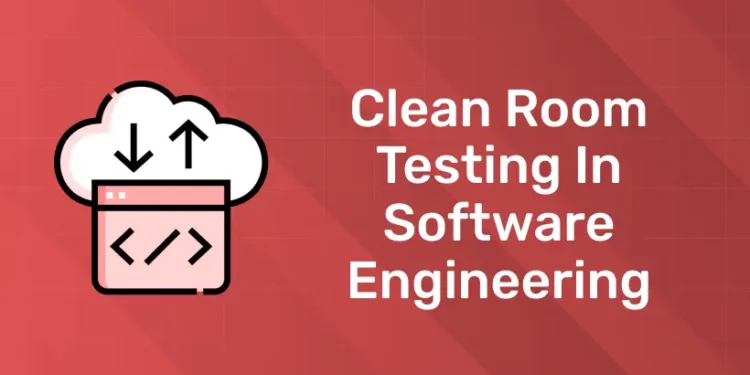Table of Contents
IBM was the first to introduce cleanroom testing. Formal verification, inspection, and walkthroughs are crucial components of this type of testing. Apart from using a compiler to perform some basic grammar testing, the programmers don’t appear to be permitted to physically inspect any of their code. The concept of computer code development is based on using a thorough evaluation process to prevent computer code flaws. It is the zero-defect computer code that this code aims for. One of the less commonly discussed, but highly effective methods is Clean Room Testing. In this article, let’s dive into what is clean room testing in software engineering, how it works, and why it might be a valuable addition to your testing strategy.
Power up your career with Entri Elevate – Full Stack Development Course!
What Is Clean Room Testing?
A strict, formal technique called “clean room testing” is used in software development to confirm and validate software without adding faults while it is being tested. Clean Room Testing adopts a proactive strategy to reduce defects from the outset of development, in contrast to typical testing methods that concentrate on identifying faults. The procedure is “clean” in that developers and testers operate inside a methodical, error-free framework to prevent mistakes from being made during the coding stage.
Objectives Of Clean Room Testing
1: What is software testing?
- Formal approaches are used to specify software requirements and design quantitatively. Early in the software development lifecycle, problems are identified and corrected through the use of incremental development, preventing them from spreading to subsequent phases.
- Both validation and verification are given a lot of weight. While validation confirms that the program meets user needs and expectations, verification makes sure the product satisfies its specified standards using formal techniques and comprehensive inspections.
- Using quantitative management that use measurements and statistical techniques, the strategy aims to regulate the software development process. One of the fundamental ideas is continuous improvement, which emphasizes on data-driven decision-making to identify and enhance areas for development.
- The cleanroom testing method involves end users to ensure that the software fulfills their requirements.
- Cleanroom testing incorporates cost-benefit analyses to determine the most economical methods for creating software of superior quality.
Master Testing Skills with Industry Experts
Become a Test Engineer: Learn Core Skills from Industry-Leading Mentors and Land High-Paying Testing Jobs!
Explore ProgramKey Features Of Clean Room Testing
- The formal specifications for the computer code that has to be developed are provided. To fine-tune the specification, a state-transition model that illustrates how the system reacts to inputs is utilized.
- When using the white room method, the computer code is divided into discrete increments that are individually developed and valid. These raises were made in the early stages of the Associate in Nursing procedure, with input from the client.
- The use of area units for management and information abstraction is limited. The process of gradually improving the specification is known as the “program development method.”
- The created computer code is statistically confirmed through thorough computer code checks. For code segments, there is no unit or module testing methodology.
- A statistical test is performed on the integrated computer code increment to determine its responsibility. Alongside the system definition, an operational profile was produced, which was supported by these applied mathematics tests.
Learn Coding in your Language! Enroll Here!
Benefits Of Clean Room Testing
- With a focus on reliability and systematic verification throughout the development cycle, Clean Room Testing produces software that is of higher quality and less likely to fail.
- With formalized and precise specifications, there is less ambiguity in the requirements, ensuring that developers, testers, and stakeholders all have a shared understanding of what the software needs to do.
- By emphasizing error-free development from the beginning, the final product tends to have fewer defects, which reduces the time spent on debugging and ensures a more stable release.
- Clean Room Testing can save money over time by lowering the number of bugs, the need for major rework, and the time spent on maintenance and updates, even though it may entail more planning and specification work up front.
Challenges Of Clean Room Testing
Despite its many benefits, clean room testing has drawbacks.
- It can take a lot of time and effort to create formal, precise requirements, and in fast-paced or agile contexts, this level of detail may be challenging to maintain.
- The procedure is inherently intricate and necessitates meticulous preparation and cooperation. It may be more difficult for inexperienced teams to execute successfully, particularly if they lack the necessary frameworks and tools.
- When changes occur during the development cycle, Clean Room Testing might not be as adaptable because it depends on predetermined standards. This might be difficult in settings like agile projects when requirements change often.
Master Testing Skills with Industry Experts
Become a Test Engineer: Learn Core Skills from Industry-Leading Mentors and Land High-Paying Testing Jobs!
Explore ProgramCONCLUSION
Clean Room Testing is an organized approach to software development that places an emphasis on defect prevention, documented standards, and incremental development. Even though its implementation takes a lot of effort, it offers significant advantages in terms of quality and reliability. This approach is advantageous for companies who provide dependable, error-free, superior software that goes above and beyond for users.
Learn to code from industry experts! Enroll here
Frequently Asked Questions
What is the difference between Clean Room Testing and traditional testing?
Traditional testing often focuses on finding bugs and defects after the software is developed. In contrast, Clean Room Testing aims to prevent defects from occurring in the first place by using formal specifications, structured development, and verification techniques. Clean Room is more proactive, while traditional testing is reactive.
When is Clean Room Testing most appropriate to use?
Clean Room Testing is most beneficial for mission-critical software where reliability, security, and quality are of the utmost importance—such as in aerospace, healthcare, and financial systems. It may not be ideal for projects that require rapid development and frequent changes.
Can Clean Room Testing be automated?
While Clean Room Testing involves a lot of formal processes and manual verification, some parts—such as statistical testing or certain forms of validation—can be automated. However, given the need for detailed planning and precise specifications, much of the Clean Room approach requires human expertise and careful execution.
Is Clean Room Testing used in Agile development?
While Clean Room Testing has similarities to Agile in its focus on high-quality outcomes, the strict and detailed specifications it requires might make it less compatible with Agile’s emphasis on flexibility and fast iterations. However, some elements of Clean Room, such as thorough verification and validation, could still be integrated into Agile practices.












